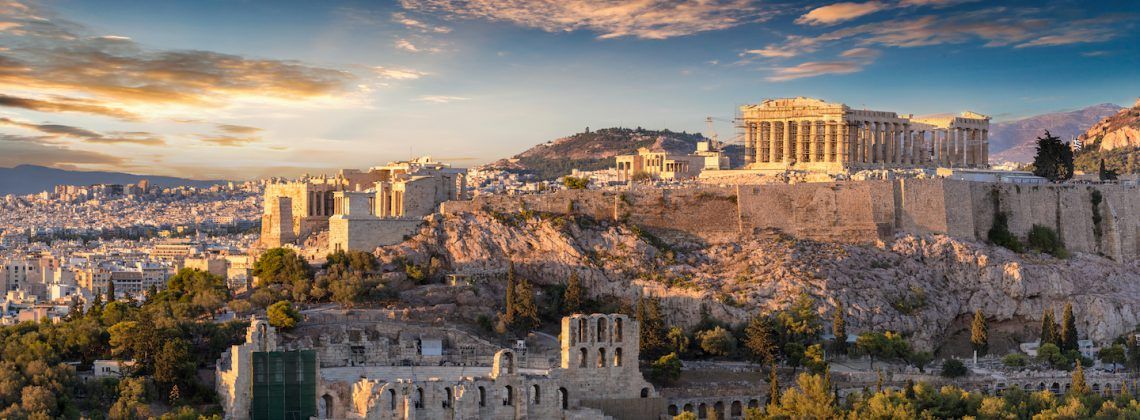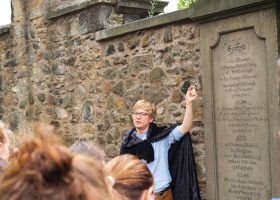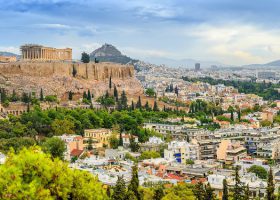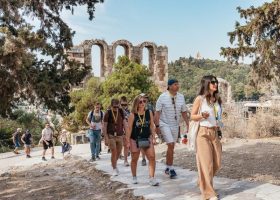Athens is a city renowned for ancient monuments like the Parthenon. But think everything in Athens is ancient history? Athens in fact boasts a history as lively and dynamic as its busy streets today. Check out this brief history of Athens written by a historian!
A Short History of Athens from Antiquity to the Present through 11 Monuments
Walking around the concrete bustle of Athens today, it can be difficult to find many traces of its richly layered history. Of course, when you look up, you’ll notice the ancient Acropolis of Athens and likely catch a glimpse of the iconic Parthenon. Certainly, you’ll see some old churches and plenty of ancient columns. Sadly, though, there is little information to help explain the history behind many of these sites and the events they’ve witnessed over the centuries.
But fear not! This article offers a primer in the history of this celebrated European capital. Athens is truly an open-air museum. You just need to know what to look for. Here we’ll discover 11 monuments to help us understand the rich history of Greece’s capital city. Before that, let’s explore the basics of the city’s history.
Athens: A Brief Historical Sketch
Our story begins way back around c.5000 BCE and the earliest known inhabitation of the Acropolis. In the coming centuries, Athens experienced various developments common in the Greek world, such as a Mycenean rule. However, as scholar Robin Wakefield says, Athens began to resemble some of its unique characteristics like democratic traditions in the 500s BCE.
Historian Paul Cartledge reminds us that by 450 BCE, Athens came under the guidance of Pericles. Moreover, Pericles ushered in a so-called Golden Age of Athens between roughly 450-400 BCE. For example, this period witnessed the construction of many celebrated ancient monuments and Athens grew wealthy and influential in the Greek world. However, by the 300s BCE, Athens fell under Macedonian rule.
Centuries of later conquerors included the Romans, Frankish crusaders, Florentine Dukes of Athens, Venetians, and Ottomans. At this point, Athens declined significantly in terms of international prestige as well as economic and demographic terms. However, by the early 1830s, Athens became the capital of the nascent Greek nation-state. Furthermore, in the last two centuries, the city has enjoyed both territorial and demographic expansion.
And with that intro, here are 11 monuments to help us better understand the history of Athens.
5000 B.C. to 500 B.C.
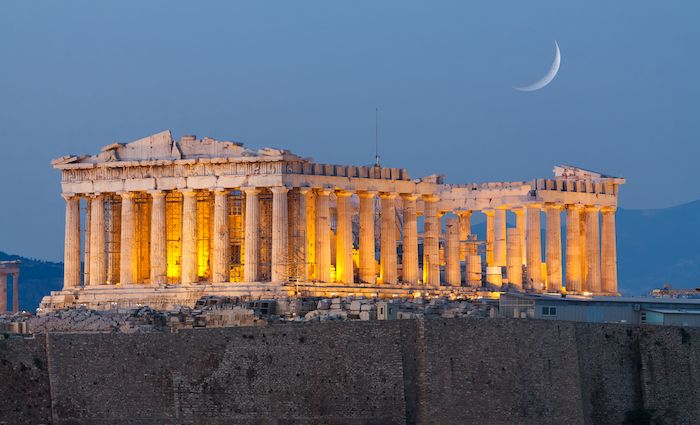
Golden Age Athens | Pericles’ Pet Project | Spiritual Heart
The Acropolis (fortified hill) and the Parthenon (temple dedicated to the goddess Athena) are without a doubt two enduring symbols of Athens through the ages. Moreover, they are excellent places from which to track the city’s fortunes. Generally, when the city experienced favorable growth, the Acropolis benefited via a construction boom in temples.
For example, when Athens grew in wealth and importance in the 6th century BCE under Peisistratus, the Acropolis received an impressive facelift with new stone temples. However, as historian Paul Cartledge tells us, the Persians ravaged these monuments in the 480s BCE.
Yet shortly after this destruction, the city’s fortunes once again revived under the leadership of Pericles. Under his leadership, as we know from archaeologists Christopher Mee and Anthony Spawforth, many damaged temples were rebuilt on a grander scale.
The Parthenon is a great example of this Athenian revival in the Golden Age of Athens. Built between 447-432 BCE, it awed any visitor. However, the Parthenon was more than just an impressive shrine to Athena. For example, historian Paul Cartledge tells us it housed the city’s extensive gold reserves.
500 B.C. to Last Century B.C.
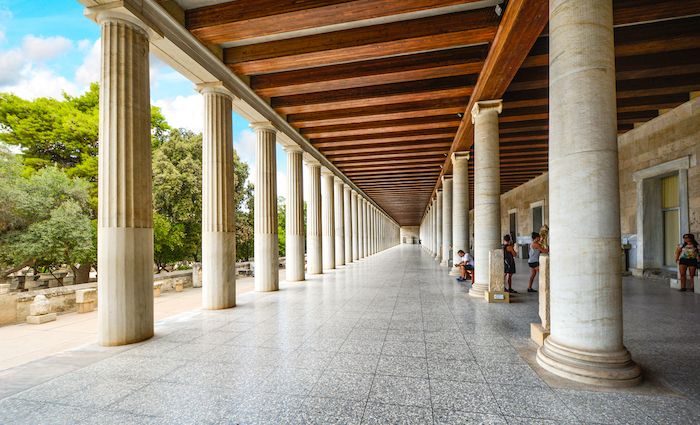
Civic Heart | Ancient Commercial Center | Athenian Democracy in Action
According to scholar Robin Wakefield, the end of the legendary Athenian kings also meant the transfer of civic political power in Ancient Athens from the Acropolis to the Agora. As a result, while the Acropolis became reserved for the gods (and the city’s gold), the Agora emerged as the place where many facets of Athenian daily life played out.
And talk about a trendsetter. Agora initially meant a meeting place. However, as historian Michael Llewellyn-Smith points out, the classical Agora in Athens redefined the term as both a meeting place, central market, and major civic space. As a result, the Agora became a place where merchants from around the Mediterranean world did business. Furthermore, Athenian men gathered here to discuss politics and vote.
In fact, you might recognize some familiar names who used to frequent the Agora. For example, Llewellyn-Smith mentions legendary philosophers like Socrates among frequent visitors to the Agora in Ancient Athens. Once Athens fell under Roman rule, the conquerors built their own agora and extended it to the classical space.
Check Out Our Best Athens Tours
The best way to visit Athenian history is by visiting the Acropolis! Tours are the way to go.
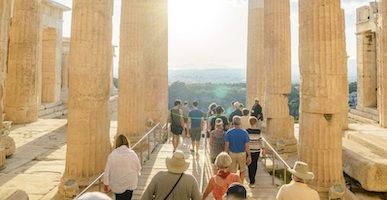
Top Rated Tour
Skip the Line Acropolis Tour with Parthenon and Museum
Towering above the modern city of Athens, explore the ancient forum home to the relics of Classical Greece. From the world’s oldest theatre to the iconic Parthenon, the Acropolis is a beacon of civilization and philosophy. Head back in time to the time of Plato and Socrates on this Skip-the-Line tour.





(5)
Starting at €80

Likely to Sell Out
Athens “Locals” Food Tour in Monastiraki
Explore the gastronomic world of Athens through the city’s central market. Enjoy homemade pastries, authentic wines, cheeses, honey-soaked donuts and much more. Your local guide will lead you through the best spots in the lively Monastiraki neighborhood for a delicious experience in Athens.





(8)
Starting at €68
Last Century B.C. to 3rd Century A.D.
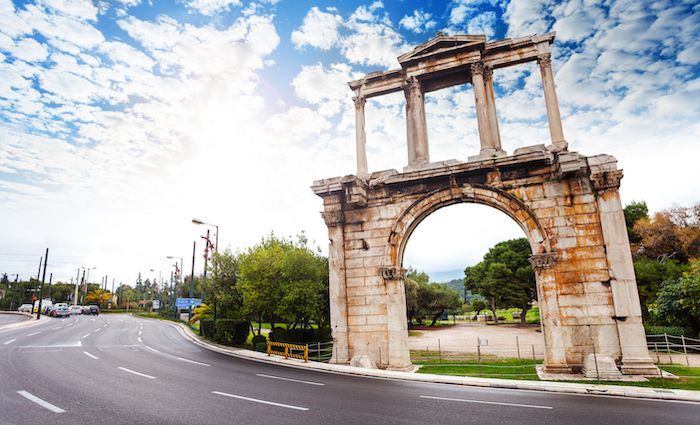
Roman Athens | For the Love of Greece | Greekling’s Gifts
Athens resembled little of its Golden Age greatness by the time Hadrian became Emperor of Rome in 117 CE. However, historian Christopher Kelly says this did not stop Hadrian from visiting Athens on multiple occasions. As archaeologists Christopher Mee and Anthony Spawforth point out, Hadrian developed a soft spot for Athens and all things Greek culture. For instance, Hadrian even earned the nickname “Graeculus” (Greekling) due to his passion for Greece and the city of Athens.
Yet Hadrian’s enthusiasm for Greece did not stop at visits to Athens. In fact, he devoted significant time and resources to rebuilding and glorifying the city. As a result, there are quite a few relics of Hadrian’s era in contemporary Athens. For example, in central Athens, you’ll find Hadrian’s Library and the Arch of Hadrian.
Hadrian envisioned dramatically changing the landscape of Athens. For instance, as archaeologist Eugene Vanderpool tells us, Hadrian had a special inscription placed on his Arch. The inscription reads “This is Athens, the ancient city of Theseus” on one side. Vanderpool explains that the other side reads: “This is the city of Hadrian, not of Theseus.” Somebody wanted to make a point.
4th Century to 15th Century
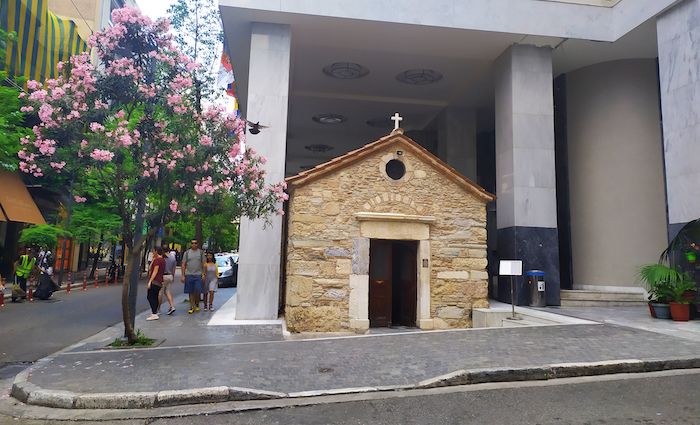
Compact | Artistic Gems | Eastern Roman Imperial Legacy
The 7th–10th century in Athens remains shrouded in ominous mystery for scholars. According to historian Michael Llewellyn-Smith, chroniclers rarely mention the city in this period and there are few archaeological remnants. However, by the 11th and 12th centuries a measure of prosperity returned under Byzantine imperial influence.
One way that scholars discern this is through the construction of several surviving stone and brick churches. For example, you’ll find the Little Metropolis church adjacent to the Greek Orthodox Cathedral of Athens.
The church’s actual name though is the Panagia Gorgoepekoos. Originally built in the 12th century, Richard Stoneman says it likely stood on the site of an earlier church founded by a Byzantine empress. However, the defining feature of this tiny church is its use of classical sculptural materials and imagery. Few buildings in Athens possess this kind of historical layering.
Although built after the Byzantine period in the 16th century, the church of Ayia Dynami (Holy Power) is a fascinating sight in Athens. How many times can you say you’ve seen a historic church built within the property of a modern luxury hotel? That’s right, today the church is located adjacent to the entrance of the Electra Metropolis Hotel.
15th Century to Greek Revolution of 1821
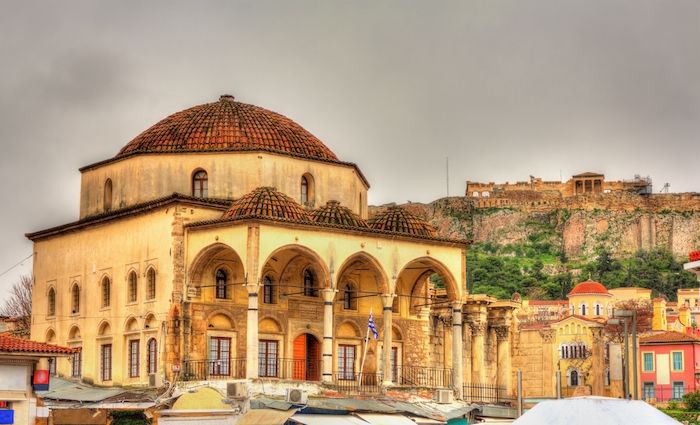
Ottoman Imperial Authority | Multi-Confessional Heritage | Political Disputes
Ottoman rule swept into Greece because of Byzantine imperial decline in the fifteenth century. For instance, historian Michael Llewellyn-Smith tells us that the Ottomans conquered Athens in 1456, 3 years after the fall of Constantinople. Despite the legendary fame of Athens, the Ottomans invested little in the city. Instead, other cities of present-day Greece like Thessaloniki (Salonica) became far more significant in the Ottoman world.
Nevertheless, there are a few surviving Ottoman monuments in Athens. In fact, several examples are within a short walk of the Acropolis. Arguably the best-preserved example is the Tzistarakis mosque located in Monastiraki Square. Constructed in 1759 by the then governor of Athens, Mustafa Aga Tzistarakis, it is located adjacent to the site of Hadrian’s Library.
However, the chronicler Panaghis Skouzes tells us that Tzistarakis soon became associated with bringing the plague to Athens. Athenians thus hoped he would be replaced by a better governor. Tzistarakis indeed lost his job, though the new governor would become infamous for his tyranny and brutality.
According to scholar Richard Stoneman, Hadji Ali (Haseki) Pasha terrorized all the city’s inhabitants, extorting money and seizing property at will. Although Athenians petitioned the Ottoman Sultan for Haseki’s removal, he managed to stay in power for 20 years. However, not long after Haseki’s fall, Athenians and other Greeks rose in rebellion against the Ottoman Empire.
1830s to 1860s
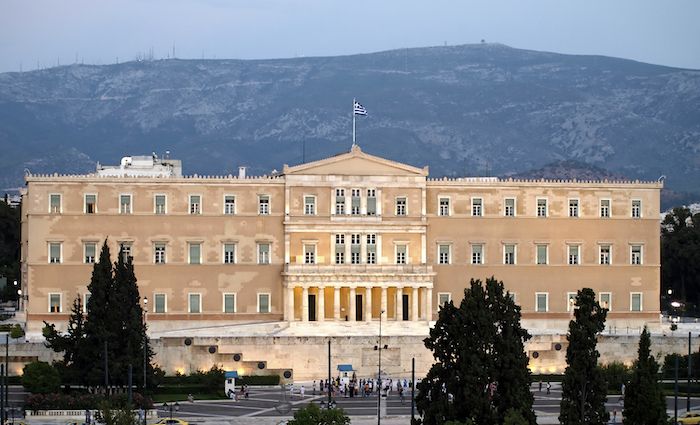
Modern Political Center | Major Civic Space | From Royal to Popular Palace
You’d be hard-pressed to find an example of a building with as varied a history as today’s Greek Parliament. To be more specific, how many buildings claim occupants as diverse as royalty, refugees, and elected officials in under two centuries? This place is certainly in rare company.
Originally built between 1836 and 1843, it became the royal palace of the newly independent Greek state’s first monarch, King Otto of Bavaria. As historian Roderick Beaton points out, the palace served as the centerpiece of an ambitious urban development program to rebrand Athens as a modern European capital city.
Soon the rest of the square, called Syntagma (Constitution), filled up with stately buildings and the first luxury hotels in modern Athens. While many of these buildings remain tied to their original use, the palace did not. Over the twentieth century, the palace transitioned from the home of royalty to shelter for refugees from the Greek-Turkish population exchange in 1923.
Finally, as historian Richard Clogg notes, the palace became the seat of the country’s parliament in 1935. Moreover, I should mention, here you’ll also find the tomb of the unknown soldier guarded by the elite and elaborately dressed Evzones (Presidential Guard).
1860s to the 1890s
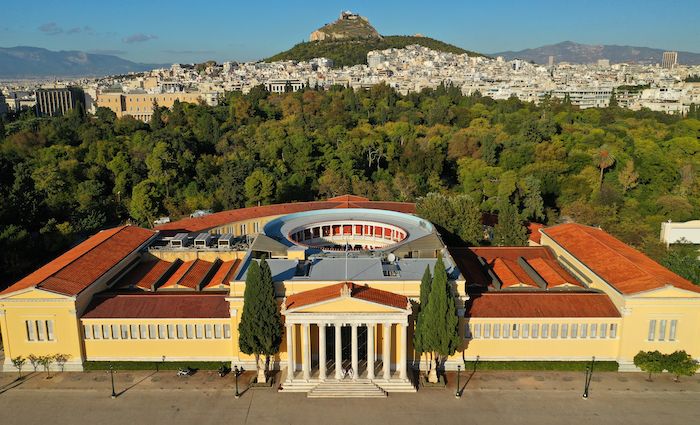
Philanthropy | Neoclassical Architecture | Public Gardens
You could say that the drive for the modern Olympic games began here with this building’s namesake Evangelos Zappas. After fighting in the Greek Revolution as a young man in the 1820s, Zappas became a leading businessman in the United Principalities (now Romania). Although he lived abroad, Zappas continued to fund projects in Greece, including this fine neoclassical exhibition hall and public garden in central Athens.
First opened in 1884, the Zappeion Hall was built by Danish architect Theophil Hansen. According to Richard Stoneman, the Zappeion likely became the first building in the world designed specifically for the purpose of resurrecting the Olympic Games. While it did not immediately lead to a modern Olympics, the Zappeion played a role in the Athens games of 1896 and 2004.
1896 First Modern Olympic
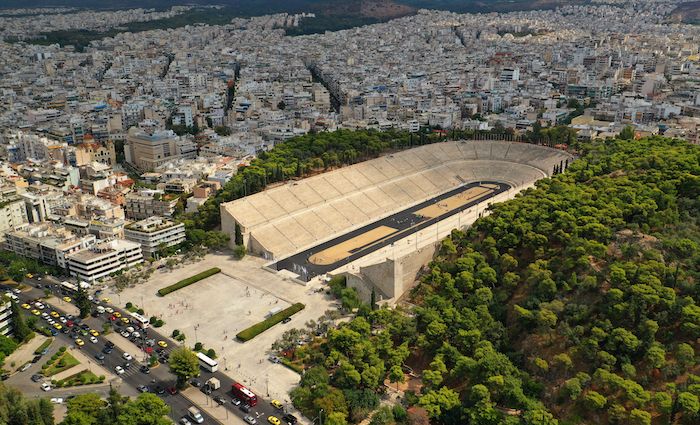
Ancient Tradition Returns | Competition | First Modern Olympic Host
You’ll no doubt be whistling the Olympic music by John Williams as we learn about this next Athenian monument. In fact, you can still visit the amazing host stadium of the 1896 Olympics. Known as the Panathenaic Stadium, or Kallimarmaro (“beautiful marble”), this venue boasts a fascinating history.
For instance, scholars believe a stadium has stood on the site as far back as the 330s BCE. Moreover, according to Richard Stoneman, wealthy Roman-era Athenian Herodes Atticus funded its reconstruction in marble during the 140s CE. By the 4th century CE though, the stadium became neglected.
Fast forward to 1869 and our friend and wealthy philanthropist Evangelos Zappas funded the stadium’s excavation. Furthermore, wealthy benefactors Georgios Averof and Dimitrios Vikelas provided crucial funding to prepare for the 1896 games. For people like Zappas, Averof, and Vikelas, the Olympiad’s return symbolized a critical step in the development of Greece as a modern European state which celebrated its rich classical heritage.
Historian Roderick Beaton tells us the architect Anastasios Metaxas then renovated the stadium and had it set for the 1896 Olympics. Thus, only in Greece can you pretend to race for the gold on the grounds of both the first modern and ancient Olympic stadiums.
The Age of the World Wars
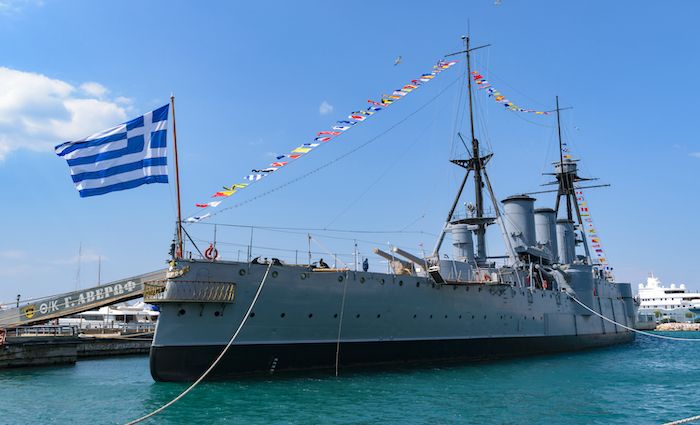
Victorious Symbol | Patriotism | Expansion
As we venture towards the coastline of the so-called Athenian Riviera, we again meet our friend and wealthy Greek Egyptian businessman Georgios Averof. Averof’s name graces the ship because he left a substantial sum in his will to the Greek navy. Averof’s wealth thus allowed the Greek government to purchase this ship in 1910 from Italy.
The battlecruiser Averof is synonymous with Greek naval victories in the twentieth century, particularly in the Balkan Wars of 1912-1913. As a result, historian Richard C. Hall says Greek territory nearly doubled in size and largely made the boundaries of present-day Greece.
And the Averof was a huge part of that territorial expansion according to naval historian Zisis Fotakis. Leading the Greek naval assault through Ottoman-held Aegean islands, it earned the nicknames “Lucky George” to the Greeks and “Devil Ship” for the Ottomans. Furthermore, the ship served in each of the country’s conflicts between WWI and WWII.
The Averof is like the Greek Navy’s equivalent of the U.S.S. Constitution in Boston. That is a historic museum ship that is symbolically still listed as active and staffed by active-duty naval personnel. Today you can tour the Averof at the Naval Tradition Park located at Flisvos Marina.
Check Out Our Best Food Tours of Athens
Visiting Athens? Cool tours and experiences fuel our blog content!

Top Rated Tour
Athens Cooking Class with Dinner and Rooftop View of the Acropolis
From delicious baked spanakopita to classic tzatziki sauce, join this cooking class to prepare authentic Greek recipes with an expert chef. With stunning views looking over the Acropolis, enjoy a 3-course dinner of your creations on this memorable experience in the Greek capital. Bring home the recipes and show your newfound culinary skills, along with amazing photos of the food and views.





(5)
Starting at €71

Likely to Sell Out
Athens “Locals” Food Tour in Monastiraki
Explore the gastronomic world of Athens through the city’s central market. Enjoy homemade pastries, authentic wines, cheeses, honey-soaked donuts and much more. Your local guide will lead you through the best spots in the lively Monastiraki neighborhood for a delicious experience in Athens.





(8)
Starting at €68
Post-1945 and Cold War Athens
An American President Abroad | Cold War | Controversial
No, you’re not in Kansas (or Missouri in this case) anymore. And so, you probably don’t expect to find a monument dedicated to Harry Truman or any other American president in Athens. But prepare to be surprised about more than such a statue’s existence. In fact, it is indeed one of the few monuments dedicated to any American president located outside the United States.
The story though goes like this.
Historian Stathis Kalyvas says that post-WWII Greece initially recovered slowly from the conflict’s devastation because of the outbreak of a full-fledged civil war (1946-49). The war pitted Greek Communist rebels against the Greek government. However, the Greek government forces, backed by heavy US involvement from 1947 finally secured victory. Thus, the Greek Communist defeat ensured Soviet influence would not enter Greece in the nascent Cold War.
Above all, American intervention in the Greek Civil War and continued influence in the country’s affairs during the Cold War emerged from the 1947 Truman Doctrine.
Furthermore, to show appreciation for US aid, a Greek American organization backed by the Athenian municipal and Greek governments commissioned a monument to the 33rd president. As a result, as historian George J. Leber tells us, in 1963 Greek and American officials dedicated the Harry Truman Statue in central Athens.
However, controversy swirled around the monument from the beginning. According to anthropologist Neni Panourgia, anti-government activists targeted the monument to protest military dictatorship between 1967 and 1974. Today though, the anger you’ll likely encounter around the monument comes from feisty pigeons.
Contemporary Athens
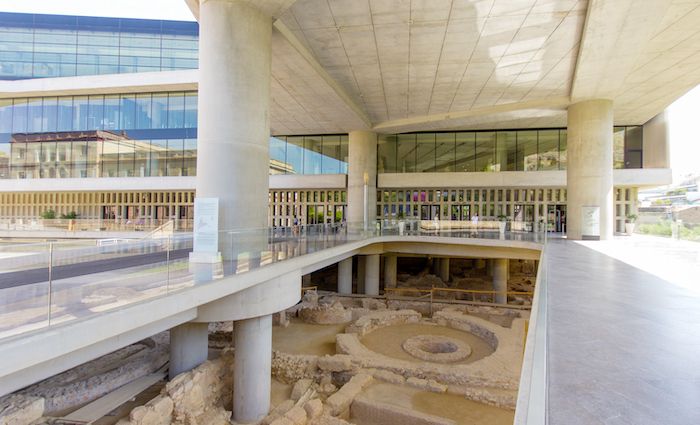
Ancient Meets Modern | Modern Marvel | Incomplete?
Where ancient meets modern, the Acropolis Museum is the perfect place to describe the essence of Athens. This sleek museum’s vast collection features artifacts from the Archaic, Classical, and Roman eras. Moreover, archaeologists uncovered all pieces within the vicinity of the Acropolis and its structures like the Parthenon.
Initially, the plan was to have the museum open in time for the 2004 Athens Olympic Games. However, as archaeologist Eugene Vanderpool explains, archaeological finds disrupted construction. Yet, because of the delay Vanderpool continues, the architects creatively changed the museum plan to incorporate these findings. In the end, the museum opened in June 2009.
Supporters of the return of the so-called Elgin marbles to Greece claim that the Acropolis Museum is incomplete without them. In fact, a floor of the museum remains ready to receive the pieces currently displayed in the British Museum.
To be sure though, there is enough on display to awe any visitor to the Acropolis Museum.
That’s all for our rapid tour through the ages in Athens! I think this calls for a Greek coffee!
